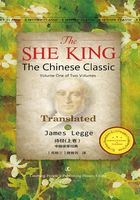
LIN CHE CHE
1 The feet of the lin:—
The noble sons of our prince,
Ah! they are the lin!
2 The forehead of the lin:—
The noble grandsons of our prince,
Ah! they are the lin!
3 The horn of the lin:—
The noble kindred of our prince,
Ah! they are the lin!


Choo considers that he phrase is a designation of king Wăn, as the 'parent' of the people; and the wife exhorts her husband ever to think of him, serving the House of Yin loyally, and to copy his example. It may be the best way to accept the view of the old interpreters. 孔=甚, 'very'.
The rhymes are—in St.1, 枚, 飢, cat. 15, t.1: in 2, 肄,棄, ib. t.3: in 3, 尾, 燬*, 燬*, 邇*, ib, t.2.
Ode 1 1. Allusive. CELEBRATING THE GOODNES S OF THE OFFSPRING AND RELATIVES OF KING WAN. The lin (Urh-ya) is the female of the k'e (麒), a fabulous animal, the symbol of all goodness and benevolence; having the body of a deer, the tail of an ox, the hoofs of a horse, on horn, the scales of a fish, &. Its feet are here mentioned, because it does not tread on any living thing, not even on live grass; its forehead (定=題, Maou;=額, Shwoh-wăn), because it does not butt with it; and its horn, because the end of it is covered with flesh, to show that the creature, while able for war, wills to have peace. The lin was supposed to appear, inaugurating a golden age; but the poet intimates that he considered the character of Wăn's family and kindred as a better auspice of such a time. Choo adopts here the explanation of 振振 given on Ode V. 1 by Maou,—仁厚貌, 'benevolent and generous-like', while Maou,I know not for what reason, changes 仁 into 信, and makes the phrase= 'sincere and generous-like'. 公子=the duke's sons. 公姓=公孫, 'the duke's grandsons'.The term 姓, 'surname', is used for grandsons, because the grandson's descendants became a new clan, with the designation of his grandfather for a clan-name. By公族 we are to understand all who could trace their lineage to the same 'high ancestor' as the duke.
The rhymes are—in st. 1, 趾, 子, cat.1, t.2: in, 2,定, 姓, cat.11: in 3, 角, 族, cat. 3, t.3: the 麟 at the end of each stanza is also considered as making a rhyme.
CONCLUDING NOTE. It is difficult for us to transport ourselves to the time and scenes of the pieces in this book. The Chinese see in them a model prince and his model wife, and the widely extended beneficial effects of their character and government.The institution of the harem is very prominent; and there the wife appears, lovely on her entry into it,reigning in it with entire devotion to her husband's happiness, free from all jealousy of the inferior inmates, in the most friendly spirit promoting their comfort, and setting them an example of frugality and industry. The people rejoice in the domestic happiness of their ruler, and in the number of his children, and would have these multiplied more and more. Among themselves, gravity of manners dignifies individuals of the meanest rank; and the rabbit-trapper is fit to be his prince's friend, guide, and shield. Purity is seen taking the place of licentiousness, both among women and men; and the wife is taught to prefer her husband's honour and loyalty to her own gratification in his society. The 4th Ode gives a pleasant picture of a bride, where yet her future work in her family is not overlooked; and the 8th, with its simple lines, shows to us a cheerful company of ribgrass-gatherers.